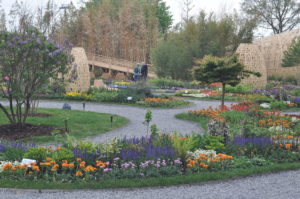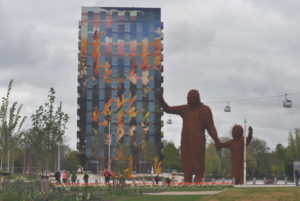Plants and Our Future
May 17th, 2022
If the Dutch Floriade 2022 is correct, plants in the future will do way more than make our yards pretty or supply us with fresh salads.

The 2022 Floriade shows many ways our cities can be greener. The striped Viewing Tower in the background is made out of recycled concrete sewer pipes, while the elm trees are floating in the lake in repurposed buoys.
Tomorrow’s plants could fuel our cars, insulate our roofs and walls, and serve as building blocks for everything from cheese to bridges.
The theme of this year’s once-every-10-year Floriade expo is “Growing Green Cities.” Exhibitors are using that theme to show how plants can solve most of the dilemmas that populating the earth has caused.
Specifically, the message is that plants make excellent sustainable, renewable, clean, and healthy alternatives to our tradition of burning fossil fuels to manufacture our voluminous daily stuff out of plastic, foam, and other synthetics.
Besides the expo’s international and display gardens, many of the exhibits show ways plants already are paving our future with creative new uses.
See a photo gallery of 2022 Floriade pictures
One bridge shows how walkway cables can be made out of flax fibers and plant-based resins instead of metal or polymers.
The show’s nature pavilion has floors and walls made out of corn fibers, rice straw, seaweed, oyster shells, and even coffee grounds instead of conventional wallboard and synthetic tile.
A mushroom-shaped pavilion that feels like it’s made out of foam or fiberglass is actually made out of rice straw, potato starch, and cattails, held together by a sort of fungal glue.
And what seems to be leather furniture is actually covered with a fabric made out of tomato stems.
It seems that with a little re-engineering and thinking outside the box, just about everything at the Home Depot of the future could come from materials that now go in our compost bins or landfills.
There’s even a whole house built out of recycled plastics and other repurposed materials.

Strawberries are growing indoors hydroponically in the Floriade’s Green House.
The most fascinating part of Floriade 2022, though, is the back side of the Green House, a huge conservatory complex that’s partly devoted to showing how much of tomorrow’s food can be produced in urban greenhouses far more efficiently than in sprawling outdoor farms.
Many of the techniques are already in use, such as the Clean Light lighting system that uses a spectrum of light that kills and prevents fungal diseases without spraying. Some 40 countries already are using the system.
Cutting-edge greenhouse “farms” also are using robots to trim tomato plants and bat-like drones to patrol greenhouses for flying insect pests, which they then chop to bits with their propeller blades.
Computerized, virtual, artificial-intelligent “growers” constantly monitor conditions and automatically adjust light, humidity, water, and fertilizer in response to how each crop is performing.
And these greenhouses are planted in stacked layers to maximize space, fed with rain collected and recirculated water to maximize water use and fertilizers, and heated with geothermal systems – a technology that not only reduces energy cost but bypasses fossil fuels altogether.
One of the most curious exhibits proposes a whole new way to produce one of the world’s favorite foods – cheese.
A Dutch company called Those Vegan Cowboys says it’s possible to make cheese by cutting out the “middle man” – cows.
Grass can be fed into a vessel containing the same microbes as are in a cow’s digestive system, which produces the same casein that then is fermented into cheese. In the exhibit, the vessel is shaped like a stainless steel cow.
Why do this? The reasoning is that it eliminates cows, which supposedly are a major contributor to methane gas production from their manure and flatulence and therefore a contributor to global warming.
A side benefit is that vegans can eat this plant-based cheese while animal activists can scratch one species off their abused-by-people list.
Although green and enviro-friendly topics abound at Floriade 2022, these are far from the only attractions in the six-month expo that runs through October 9 in the Dutch city of Almere.

China’s exhibit features some of the best gardens.
The 148 acres is a sort of world’s fair of horticulture that also showcases display gardens from a couple of dozen countries, including China’s bamboo forest, Germany’s Biotopia rooftop gardens, Qatar’s green-in-the-desert landscape, and, of course, lots of bulbs and flowers planted by the host Dutch horticulture industry. The U.S. isn’t participating.
Some other interesting features of Floriade 2022:
* A floating forest of about 20 Dutch elm trees that are growing in buoys bobbing in the surrounding lake.
* A university building that not only has a green roof but plant-covered walls.
* A Flores Tower that’s a residential high-rise covered in glass images of flowers.

The Flores Tower and Beehold statue made out of 10,000 steel bees are two signatures of the 2022 Floriade.
* A 140-foot-tall viewing tower built out of recycled concrete sewer pipes.
* A living plant encyclopedia of beds grouped in alphabetical order by the plants’ names.
*A two-person waving-people sculpture made out of 10,000 steel bees.
*And an orchard showing all sorts of space-saving ways to prune and grow fruit trees.
When Floriade ends, the land will become a new hyper-green neighborhood of Almere called Hortus.
Read more about Floriade 2022 at the show’s website.







